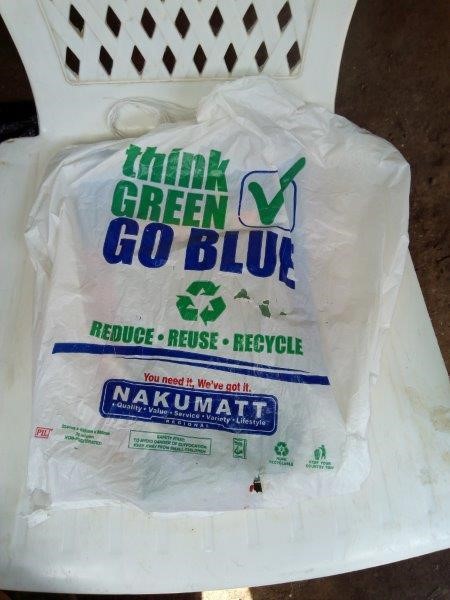
By Nelly Muturi
The eighth REACHOUT Consortium meeting was held in Malawi from 11th to 16th September 2017. The meeting started on a high note with a Knowledge Café that provided an opportunity for all country teams to showcase their Quality Improvement (QI) work and learn from the Malawi teams from Salima and Mchinji districts. Part of the day’s activities was to display the contents of a standard community health worker backpack from each of our countries. I had the privilege of presenting the contents of the backpack from Kenya based on what I had observed during the course of our field work.
What is in the bag?
A standard Community Health Volunteer (CHV) backpack contains both work-related and personal items used in the day-to-day life of a CHV. Work related articles include; the Middle Upper Arm Circumference (MUAC) tape, standard Ministry of Health reporting tools (service delivery logbook and the referral booklet), a notebook and a pen, de-worming tablets, water purifying tablets, condoms, pain killers (Paracetamol) and Information, Education and Communication (IEC) materials that mainly focus on Maternal, Newborn and Child Health (MNCH), and Water Sanitation and Hygiene (WASH), Sexual and Gender-Based Violence messages (SGBV).
Women’s backpacks often differ significantly to men’s. Women can carry personal effects such as a khanga[1], body lotion, a mirror, or sanitary pads. In this way the backpack replaces her handbag. Not all CHV backpacks are the same. All CHVs should be provided with a bag for work. But in reality many are not and so they have to improvise. A lot of CHVs use polythene bags (which are now banned in Kenya) or personal handbags (for woman CHVs) as their backpack. The ones with branded backpacks consider them a motivating factor.
What do the contents of the bag tell us?
Looking at the bags helped me to reflect on the multiplicity of tasks that they have to perform and how that impacts on what they carry while executing their day-to-day responsibilities. A CHV has multiple roles and does not only serve their community as a health worker. They may be a parent, and are certainly a community leader in one way or another, and as such have to balance this with serving the community.
In Kenya, CHVs are volunteers and do not receive monthly pay for services. Their key responsibilities include; health promotion and education, growth monitoring for children under five years of age and referral of community members to link health facilities. In other settings, CHVs have more responsibilities for example in Malawi Health Surveillance Assistants (equivalent of CHVs) have up to 500 roles which they support to implement as part of health service delivery at community level.
CHVs have standard reporting tools developed and approved by the Ministry of Health (MoH) which include the Service Delivery Log Book (MoH 514) and the referral form (MoH 100). The standard MoH 514 is a large book that is in the words of CHVs, “very bulky and difficult to carry around.” Consequently, this contributes to a huge load on a standard CHV backpack because a CHV has to carry the reporting tools every time they are conducting a household visit.
Vertical CHV programmes have negatively impacted on backpack contents. Projects in different areas such as HIV, malaria, maternal health etc. introduce new tools for CHVs resulting in additional responsibilities which they are expected to deliver and report on. In some instances, a CHV may be required to fill up to four different tools in a single household in order to report on different programme areas. Reflecting on this, I appreciated the dilemma CHVs face on which roles to prioritize over others. As a result, most of the time CHVs prioritize working on what is easiest, what is paid for, or what they feel is important to them as opposed to trying to do and document everything.
The Knowledge Café provided us a great experience to walk in the shoes of a CHV and to appreciate the relevance of each of the contents by taking the visitors through each component of the backpack. Of particular interest was the referral form and participants were wanted to hear how the CHVs used it and how it supported referral follow up to monitor uptake of health services by community members at facility level. In addition, it provided an opportunity to appreciate the multiple roles of CHVs in communities. It allowed researchers to understand the complexities of the health systems which CHVs work in and possibly understand why or how CHVs make choices when faced with multiple responsibilities.
As a researcher, this experience highlighted the need for community health worker programmes to integrate reporting into tools that are already in use by CHVs and to seek their input when developing new ones. It also demonstrated some of the ways governments, policy makers, and programmes can keep CHVs motivated. Motivation approaches should be both financial and non-financial incentives like branded CHV backpacks. On a positive note, the exhibition experience provided an opportunity to show how the CHVs have adapted to the different settings and despite the challenges that they face - especially the lack of adequate commodities to do their work. It also showed that CHVs are willing to go out of their way to use their own personal effects to facilitate their service provision at community level.
[1] A traditional piece of cloth used as a wrapper; adapted from the Swahili culture in the Kenyan Coastal region.
Recent news
- Village Health Volunteers in Indonesia: Negotiating changes in health seeking behavior with pregnant women, 18 September 2017
- Measuring quality in Malawi’s community health system: Barriers and challenges, 31 August 2017
- Do devolved Kenyan county governments prioritise universal health coverage?, 10 August 2017

This project is funded by the European Union.
